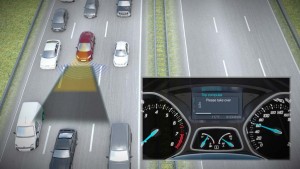With Nevada already licensing prototype autonomous vehicles, automakers are racing to come up with new technology that can simplify the task of driving, maneuver through traffic and reduce the endemic problem of driver distraction.
At a preview of its 2013 line-up Ford also revealed some of the high-tech driver assistance systems it is hoping to introduce over the next several years, including one that could reduce traffic gridlock, another that simplifies the task of backing into a tight parking spot.
“Developing these technologies is part of the first step in a journey toward a more connected future,” said Paul Mascarenas, Ford chief technical officer and vice president, Research and Innovation. “It’s an undertaking we believe will save time, conserve resources, lower emissions, improve safety and help reduce driver stress.”
Traffic gridlock has become one of the biggest problem facing not only American motorists but those in most major cities around the world, from Boston to Berlin to Beijing. Experts believe that rather than continually adding more roads, however, smart technological solutions can smoothly squeeze more vehicles onto existing pavement.
That’s where the prototype Ford Traffic Jam Assist system comes into play. It combines camera and radar hardware — already in use for less advanced systems like Forward Collision Alert and Lane Departure Warning – with automatic steering that can seamlessly maneuver a vehicle through traffic.
Ford cites studies indicating that if even a quarter of the vehicles on the road used such technology travel times in urban traffic could be trimmed by more than a third.
“Drivers spend more than 30 percent of their time in heavy traffic,” said Joseph Urhahne, engineer with Ford Research and Innovation. “Traffic Jam Assist could help make traveling through congestion a more relaxing experience and, by keeping pace with the flow of traffic, potentially help relieve road congestion.”
Another Ford system under development takes the maker’s current parallel parking technology to the next level. A number of Ford products already offer an optional park assist system but the updated system could be used in parallel parking situations, not just for parallel parking. That would make the technology useful in a significantly greater number of situations, especially in parking lots.
Ford also says it may have a technological solution to one of the modern world’s most perplexing technological problem: distracted driving. According to federal data that is responsible for nearly a million crashes annually – along with the loss of thousands of lives, about 11% of total U.S. highway fatalities.
Many states and municipalities are passing strict new laws intended to limit the use of cellphones and texting while behind the wheel but enforcement is a challenge.
Ford has already built in a “Do Not Disturb” feature that can be activated on its Sync system, blocking incoming calls and text messages. But the next step would be a smart system that would specifically knew when the time is right – or wrong – to take a call.
“It is research but not science fiction,” said Jeff Greenberg, a senior technical leader at Ford Research and Innovation.
The technology could eventually rely on a variety of sensors, including those measuring heart rate or palm sweat on the steering wheel, to determine when to disconnect a call.
Such a feature could be available within the next few years, Ford officials suggest, while the other new Ford systems might also be available in the not-too-distant future.

